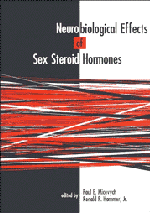Book contents
- Frontmatter
- Contents
- List of contributors
- Dedication
- Preface
- Acknowledgments
- Part I Sex steroid–responsive circuits regulating male and female reproductive behaviors
- 1 Hormonal influence on neurons of the mating behavior pathway in male hamsters
- 2 Neural circuitry for the hormonal control of male sexual behavior
- 3 Estrogen receptor mRNA: neuroanatomical distribution and regulation in three behaviorally relevant physiological models
- 4 Hormonal regulation of limbic and hypothalamic pathways
- Part II Sex steroid interactions with specific neurochemical circuits
- Part III Cellular and molecular mechanisms regulated by sex steroids
- Index
1 - Hormonal influence on neurons of the mating behavior pathway in male hamsters
Published online by Cambridge University Press: 15 October 2009
- Frontmatter
- Contents
- List of contributors
- Dedication
- Preface
- Acknowledgments
- Part I Sex steroid–responsive circuits regulating male and female reproductive behaviors
- 1 Hormonal influence on neurons of the mating behavior pathway in male hamsters
- 2 Neural circuitry for the hormonal control of male sexual behavior
- 3 Estrogen receptor mRNA: neuroanatomical distribution and regulation in three behaviorally relevant physiological models
- 4 Hormonal regulation of limbic and hypothalamic pathways
- Part II Sex steroid interactions with specific neurochemical circuits
- Part III Cellular and molecular mechanisms regulated by sex steroids
- Index
Summary
Introduction
Steroid hormones produced in the gonads are a prerequisite for mating behavior in the male Syrian hamster, as in most male mammals. While a substantial body of early research was directed toward defining the hormonal requirements (both quantity and identity) for this behavior, more recent studies have focused on hormone metabolism, receptor distribution, and mechanisms of steroid action in the central nervous system (CNS). This chapter explores the transduction of hormonal signals by steroid receptor–containing neurons to facilitate sexual behavior in the male hamster.
Hormonal requirements for copulation
Copulation in the male Syrian hamster
The sequence of copulation in the male Syrian hamster has been reviewed previously (Siegel 1985; Sachs and Meisel 1988). However, a brief description of the behaviors expressed during mating would be helpful for understanding the critical role that hormones play in maintaining this activity. Figure 1.1 illustrates sexual behavior over a 10-minute period in a sexually experienced male. Initial contact with a receptive female is characterized by investigation of the female's head and flank, followed by extensive sniffing and licking of the anogenital region. Through this activity, the male receives chemosensory stimulation via the vomeronasal organ and olfactory mucosa. The ability to perceive chemosensory signals and the integrity of the neural pathways that transmit chemosensory stimuli are essential for copulation, because disruption of chemosensory cues immediately and permanently abolishes mating (reviewed by Sachs and Meisel 1988). In a sexually experienced male, anogenital investigation of the female is followed shortly by a series of mounts and intromissions, interspersed with brief (1- to 2-second) grooming of the penis and perineum.
- Type
- Chapter
- Information
- Neurobiological Effects of Sex Steroid Hormones , pp. 3 - 39Publisher: Cambridge University PressPrint publication year: 1995
- 25
- Cited by



